What is a California Promissory Note?
A California Promissory Note is a written agreement in which one party promises to pay a specified amount of money to another party under agreed-upon terms. This document outlines the loan amount, interest rate, repayment schedule, and any penalties for late payment. It serves as a legal record of the debt and the obligations of both parties involved.
Who can use a Promissory Note in California?
Any individual or business can use a Promissory Note in California. It is commonly utilized between friends, family members, or business partners. However, it is essential that both parties understand the terms and conditions outlined in the note before signing.
What should be included in a California Promissory Note?
A complete California Promissory Note should include the following elements: the names and addresses of both the borrower and lender, the principal amount of the loan, the interest rate (if applicable), repayment terms (including due dates), and any penalties for late payments. Additionally, it should specify whether the note is secured or unsecured, and it is advisable to include a section for signatures and dates.
Is it necessary to notarize a Promissory Note in California?
Notarization is not required for a Promissory Note to be legally binding in California. However, having the document notarized can provide an extra layer of security and help prevent disputes about the authenticity of the signatures. It is often recommended for larger amounts or more formal agreements.
What happens if the borrower fails to repay the loan?
If the borrower fails to repay the loan according to the terms outlined in the Promissory Note, the lender has the right to take legal action. This may include filing a lawsuit to recover the owed amount. The lender may also be able to collect any accrued interest and fees as specified in the note.
Can a Promissory Note be modified after it is signed?
Yes, a Promissory Note can be modified after it is signed, but both parties must agree to the changes. It is advisable to document any modifications in writing and have both parties sign the amended agreement. This helps ensure clarity and prevents misunderstandings in the future.
Are there different types of Promissory Notes?
Yes, there are different types of Promissory Notes. Some common types include secured notes, which are backed by collateral, and unsecured notes, which are not. Additionally, notes can vary based on their terms, such as fixed-rate versus variable-rate interest, or short-term versus long-term repayment schedules.
Where can I obtain a California Promissory Note form?
You can obtain a California Promissory Note form from various sources, including legal stationery stores, online legal form providers, or through legal professionals. Ensure that the form you choose complies with California laws and is suitable for your specific situation.
